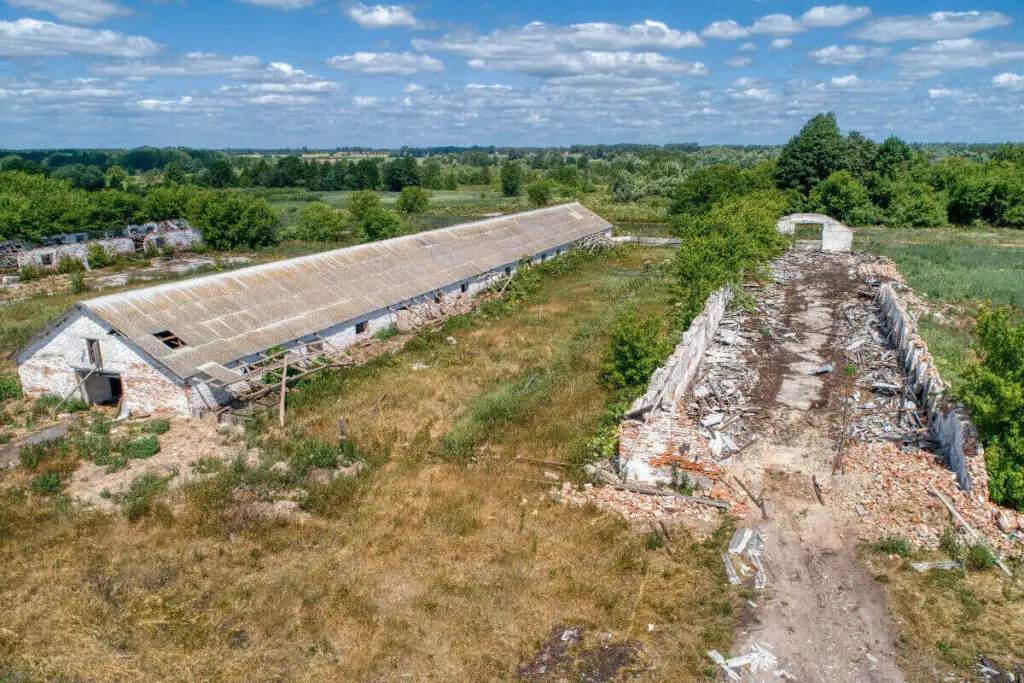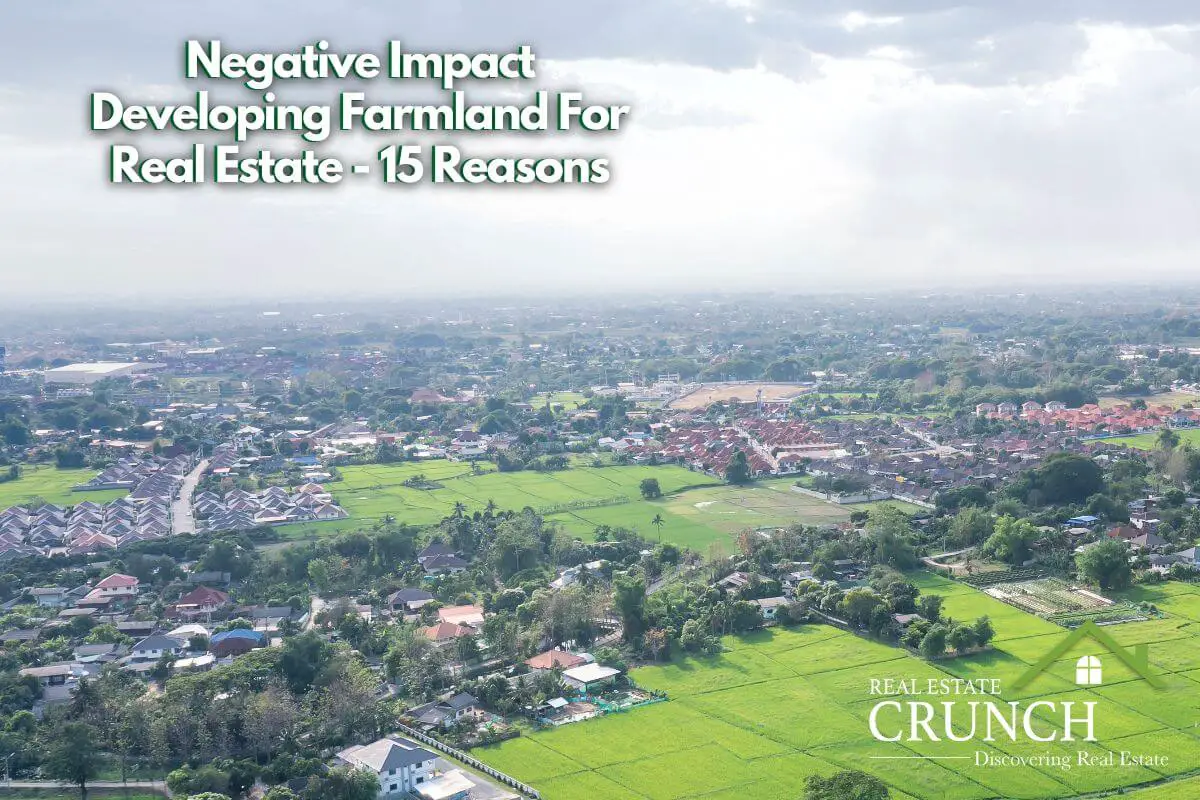In the race to modernize and urbanize, many countries rapidly convert fertile farmlands into concrete jungles, paving the way for residential and industrial development.
While the spread of urban areas and infrastructural advancements might seem like signs of progression and affluence, this aggressive shift significantly affects the countries, their populace, and our planet. In the long run, all farmland development can hurt countries economically and our planet.
Table of Contents
- 15 Reasons For The Negative Impact Of Developing Farmland For Real Estate
- Farmers Lose Their Income Source
- Increased Dependency On Food Imports
- Environmental Degradation
- Loss Of Carbon Sinks
- Water Table Depletion
- Increased Pollution
- Food Price Hike
- Loss Of Cultural Heritage
- Soil Degradation
- Increased Vulnerability To Climate Change
- Strain On Infrastructure
- Reduced Employment Opportunities
- Strain On Global Food Supply
- Impact On Local Economies
- Mental Health Implications
- Balancing Urbanization And Farmland Preservation: A Path To Sustainable Growth
- Finding The Right Middle Ground With Real Estate Development
- Related Question
15 Reasons For The Negative Impact Of Developing Farmland For Real Estate
There are many negative impacts for farmers to stop farming their land and turn their farmlands into housing developments instead. Some of these impacts can negatively impact a country more negatively than others.
Here are 15 reasons why we should reconsider and restrain the hasty development of farmland.
Farmers Lose Their Income Source
For many families, farming is not just a profession—it’s a way of life passed down through generations. By transforming farmlands into real estate, these families lose not just their lands but also their primary source of income. This can lead to a spiral of financial instability and poverty.
Increased Dependency On Food Imports
A reduction in arable land directly impacts a nation’s ability to produce its food. Over time, this can increase import dependency, making nations vulnerable to global market fluctuations, tariffs, and potential food shortages.
Environmental Degradation
Farmlands are more than just open fields. They often encompass various ecosystems that support diverse flora and fauna. These ecosystems get disrupted or obliterated once the land is developed, causing an immeasurable biodiversity loss.
Loss Of Carbon Sinks
Plants, especially trees and crops in farmlands, absorb carbon dioxide and release oxygen, serving as vital carbon sinks. Their loss intensifies global warming as fewer plants absorb the ever-increasing carbon emissions.
Water Table Depletion
Concrete structures and roads limit the ground’s ability to absorb rainwater, affecting the natural replenishment of groundwater levels. This can lead to reduced water availability and even drought-like conditions in severe cases.
Increased Pollution
Industrial and residential areas generate significantly more pollution than open farmlands. As cities expand, pollution levels rise due to increased vehicular traffic, industrial processes, and waste generation.

Food Price Hike
A decline in local food production often increases prices due to the added costs of importing food from other regions or countries.
Loss Of Cultural Heritage
Many farming practices and rituals are deeply rooted in a region’s culture and history. The loss of farmlands often means the erosion of these traditions and a loss of cultural identity.
Soil Degradation
Constant construction and urban sprawl lead to soil compaction and degradation. This makes it hard for the land to revert to its original productive state, even if we later realize the importance of restoring it.
Increased Vulnerability To Climate Change
Farmers, with their vast knowledge of the land and environment, often implement practices that guard against soil erosion, flooding, and other climatic challenges. By eliminating these safeguards, we increase our vulnerability to the adverse effects of climate change.
Strain On Infrastructure
Rapid urbanization without adequate planning results in overburdened infrastructure. This includes transportation, sewage, and waste management challenges, which lower residents’ quality of life.

Reduced Employment Opportunities
A significant proportion of the world’s workforce is engaged in agriculture. By reducing the available farmland, we indirectly reduce employment opportunities for millions.
Strain On Global Food Supply
As more countries convert their farmlands, global food production reduces. This strains the global food supply chain and might lead to global food crises if not checked.
Impact On Local Economies
Farmlands often support local economies by providing raw materials for local industries, such as food processing units. Their loss can cripple these industries and cause economic downturns in regions dependent on them.
Mental Health Implications
Open green spaces have been shown to have numerous mental health benefits, including reduced stress and better cognitive function. Their loss can have profound effects on the mental well-being of residents.
While urbanization and industrialization are vital for a nation’s development, striking a balance is crucial. The unchecked conversion of farmland to real estate poses dire consequences for the immediate stakeholders and the world. Sustainable planning and development and preserving our agricultural heritage are crucial steps toward a balanced and prosperous future.
Balancing Urbanization And Farmland Preservation: A Path To Sustainable Growth
Urbanization is a double-edged sword. On one side, it offers the allure of modern homes, better infrastructure, and a plethora of amenities.
Conversely, it jeopardizes our farmers’ livelihood and risks our environment’s health. The question arises in the ever-growing war between urban expansion and agricultural needs: How can we strike the right balance?
Urbanization’s Dual Facets
The growth of cities and towns is a natural progression as societies evolve. Urban centers attract populations with the promise of improved living standards, job opportunities, and better healthcare and education.
The rise of skyscrapers, shopping complexes, and better transportation networks are evident marks of this growth. However, this upward trajectory of urban development often overlooks its underlying cost: the reduction of fertile farmland.
Every brick in a new housing project or factory forever alters a piece of land that once contributed to our food supply chain.
The Silent Sufferers: Our Farmers
As city boundaries expand, farmers frequently find themselves edged out. Agricultural lands are bought, often below their potential value, and farmers are left grappling with the loss of their land and their primary source of income.
For many, farming isn’t just a job; it’s a legacy passed down through generations. The abrupt shift to urban lifestyles can economically and emotionally challenge these families.
Environment At Risk
Beyond the immediate human impact, the environment bears the brunt of aggressive urbanization. Farmlands act as natural carbon sinks, help in groundwater recharge, and are often rich in biodiversity.
Their conversion leads to increased carbon emissions, potential water shortages, and a loss of many species that once thrived there.
Finding The Right Middle Ground With Real Estate Development
So, how do we navigate this complex issue? The solution lies in sustainable urban planning.
- Zoning And Land Use Planning: Governments can demarcate agricultural zones, ensuring that a certain percentage of land remains dedicated to farming. This protects farmers and ensures food security for the growing urban population.
- Vertical Urbanization: Instead of spreading out, cities can grow upwards. Skyscrapers and multi-story buildings can house more people in a smaller footprint, preserving the surrounding land.
- Promote Urban Farming: Integrating green spaces and farms within urban settings can meet both food demands and provide city dwellers with green spaces with numerous mental and physical health benefits.
- Invest In Farming Technology: Modern technology can help farms be more productive in smaller spaces, reducing the need to convert more land for food production.
The equilibrium between urbanization and farmland preservation is delicate but achievable. By valuing both the shimmering allure of cities and the rustic charm of our countryside, we can create a future where progress does not come at the expense of our roots or our planet.
Real Estate Crunch gives you real property and real estate information and advice. We offer a free monthly newsletter; you can sign up for our newsletter by clicking here.
We also have a weekly podcast called “Real Estate Crunch,” found on all major podcast platforms. Listen to our podcast by clicking here.
Follow us on our social media platforms – Facebook and Instagram.
Related Question
Can You Sell A Property Without The Original Sales Deed?
Selling a property without the Sales Deed is possible, but it is essential to take all necessary steps to protect both the buyer and seller from potential risks or legal issues. You must do your due diligence; obtaining proper legal advice is always recommended when buying or selling a property.
By clicking here, you can read more about Can You Sell A Property Without The Original Sales Deed?
What Is A Proof Of The Ownership Of A House?
The deed is the proof of ownership of the house or land. The deed is a legal instrument that shows who owns the home and land. There are many kinds of deeds, from the warranty deed, special warrant, bargain and sale deed, and quitclaim deed. Even though they have some similarities, these deeds also have many differences.
By clicking here, you can read more about What Is A Proof Of The Ownership Of A House?
Curbio Your Key To Selling Your Home Quickly & Higher Price
The concept of Curbio is that they will work with your realtor and help you do the repairs you need to get your home ready to sell. Their team of professionals will help remove the headache of selling your home while allowing you to get top dollar. Curbio will help you to determine what repairs need to be done to sell your home quickly and at a higher price.
By clicking here, you can read more about Curbio Your Key To Selling Your Home Quickly & Higher Price.


